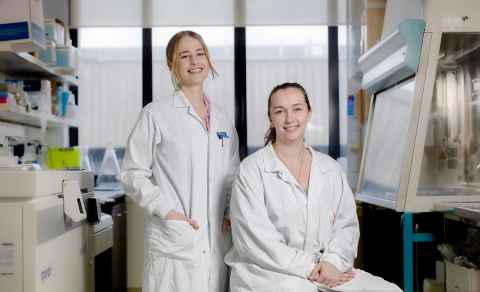Brain research reveals long-term impact of contact sport head injuries
26 June 2023
A sophisticated brain tissue labelling technique is helping researchers at the University of Auckland shed light on the long-term impacts of contact sports concussions.

The work is being spearheaded by Dr Helen Murray, a research fellow at the Centre for Brain Research who is carrying out ground-breaking work focusing on brain changes in former athletes diagnosed with Chronic Traumatic Encephalopathy (CTE). She is being assisted by Chelsie Osterman, a PhD student in Biomedical Science with expertise in neuroinflammation.
CTE has only recently been defined as its own distinct disease, meaning research into the field is relatively new. Public awareness of CTE is growing, however, helped in part by a number of former All Blacks and professional sportspeople speaking out about their experiences of the effects of repetitive brain injuries.
Helen says it’s not just professional sportspeople who are potentially affected by CTE, but also people playing amateur sports, victims of domestic abuse and people serving in the military. And although it’s currently only possible to confirm if someone had CTE by analysing their brain tissue after they pass away, Helen says the goal is to be able to find markers – through a blood test or MRI scan – that can indicate whether someone has the disease not only while they are still alive, but before they even start to show symptoms. That could ultimately open a window where intervention is possible.
Helen’s research fellowship position is funded by the Health Education Trust, while Chelsie’s doctoral studies are philanthropically supported by Peter and Wendy Gillespie.
Under Helen’s supervision, Chelsie has learnt an advanced brain tissue labelling technique called ‘multiplex immunohistochemistry’, a powerful tool that gives researchers access to more than 20 times more information from a single piece of brain tissue compared to other methods.
Chelsie says learning such a specialised skill is “incredible” and that working with Helen has “led to an amazing opportunity where I not only got to utilise this amazing technique to unravel the complexities of the human brain, but I could utilise this information to meaningfully contribute to an understanding of CTE”.
Similar to Alzheimer’s disease, CTE is characterised by the accumulation of a protein called tau, which clumps in the brain and causes dense – and highly damaging – tangles inside cells.
While both Alzheimer’s and CTE have similar symptoms, such as cognitive decline, memory loss and behavioural dysregulation, the main difference between the two diseases is where the tau builds up. In people suffering from Alzheimer’s the tau forms in the hippocampus, the area responsible for learning and memory. In CTE the clumps form in the cortical sulci – the bottom of the valleys between the folds in the brain – mostly in the frontal cortex and sometimes in the temporal cortex as well.
Chelsie says her interest in researching CTE was sparked by an interest in “the complexity of the human brain and the devastating impact neurological and neurodegenerative conditions have on the individual, their families, and the community”.
In her doctoral work, she will use multiplex immunohistochemistry to analyse blood vessels and inflammation in the brain to see how exactly tissue in brains with CTE differs from normal ageing, as well as from related diseases like Alzheimer’s.
“Knowing that my research is funded by a philanthropic donation is deeply gratifying,” says Chelsie. “It not only provides the financial resources needed to carry out high-quality research but also reaffirms the importance and impact of our work. This support acts as a constant reminder that the research we do can make a real difference in people's lives and is valued by the community.”
Media contact
Helen Borne | Communications Manager
Alumni Relations and Development
Email: h.borne@auckland.ac.nz